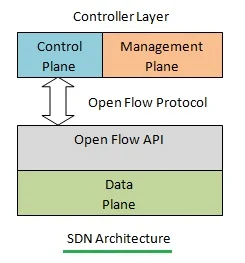What is SDN ?
The SDN in networking terminology refers to Software-Defined Networking. It is an innovative network architecture that aims to enhance the flexibility, efficiency, and manageability of computer networks. In traditional networking, network devices such as routers & switches have their control plane and data plane tightly integrated. This makes it challenging to adapt to changing network requirements and traffic patterns. SDN separates the control plane from the data plane, enabling centralized control and programmability of the network.
We have seen the networking where in routers, switches, firewalls are installed based on the networking requirement after initial network layout. There will be problem when the requirement gets changed at later point of time. It will be difficult to modify the existing networking components and only option will be to dump the existing one and replace the one with higher capacity. Here software components of the networking devices can not be modified. This leads to the development of SDN.
In SDN software components can be customized and can also be configured based on requirements. This can be done independent of any hardware device i.e. all the networking hardware devices can be defined by changing the software installation at deployment time. These helps in enhancing the data flow across the systems. The effect of SDN can be easily felt by networking service providers and big business enterprises but not by the end user. In contrast, the end user of networking system will feel enhanced services, security and seamless usage of service.
The other major enabler of SDN evolution are as follows:
• Change in the usage of traffic from different kind of networking devices by the user.
• Demand of scalability of storage, computing and networking resources by large and
dynamic enterprises.
• Massive parallel processing on the servers and big data flow between them.
SDN moved distributed data centres to the cloud region and this is considered to be major motivator for SDN evolution.
SDN Architecture in networking terminology

The diagram depicts SDN architecture, consisting of Application layer, controller layer and data plane layer. The traditional network had control plane, data plane and management plane in a single networking device. In software defined networks control plane and management planes are separated and known as controller. Controller communicate with data plane using Open flow protocol and with open flow API integrated into data plane layer. Application layer sits on top of controller.
Open flow protocol basically allows external control software i.e. controller to control the data path of a switch by using flow table.
The functions of key components of SDN architecture are as follows.
• Data Plane: This is where network traffic flows, handled by switches and routers.
• Control Plane: This is the brain of the network, managing routing, traffic policies and network topology.
• Application Plane: Software applications that control and manage the network using APIs provided by the control plane.
Benefits of using SDN
The major benefit of adopting the SDN is world's largest networks such as google, yahoo, verizon, microsoft, facebook, NTT Communication Deutsche Telekom already
supports SDN based architecture.
• The other benefit is that centralized management of networking devices.
• Improvement in automating the network components.
• Enhancement to end user usability.
• SDN can be used for multi-tenancy application.
• Multi-tenancy is the network where in distributed data centers installed for different customers can communicate securely.
Here multiple tenants can share the same physical resources. Also each tenant is assigned with unique logical resources.
In summary SDN delivers networks with flexibility, scalability and efficiency.
SDN Standards
ONF(Open Network Foundation) is working towards finalization of standard for SDN. The organization is working towards standardization of Open Flow Protocol which is responsible for communication between control plane and data plane. This helps network devices from different vendors interoperate and provide high performance granular traffic control among them. Open Flow based SDN is under deployment.
SDN is driven mainly by user companies. There more than 66 companies working towards the vision to make SDN ubiquitous and also to foster the vibrant market for SDN products and services. To make this happen other than standard finalization ONF is working to educate the market, protecting IPs and working towards SDN architecture framework.
SDN Products
Brocade MLXe 24 port 10GbE module along with 100Gb Ethernet capability MLXe core router is open flow enabled for SDN. Brocade also offers ADX switch which provides multi-tenancy support. The switch can optimize resource utilization by consolidating multiple devices into one.
Conclusion : In summary, SDN architecture separates the control, data, and application planes of a network. This offers benefits such as centralized control, flexibility, network programmability, optimized traffic management, simplified management, resource efficiency and improved security.
RF and Wireless Terminologies
What is Difference between
Difference between SC-FDMA and OFDM
Difference between SISO and MIMO
Difference between TDD and FDD
Difference between 802.11 standards viz.11-a,11-b,11-g and 11-n
OFDM vs OFDMA
CDMA vs GSM
